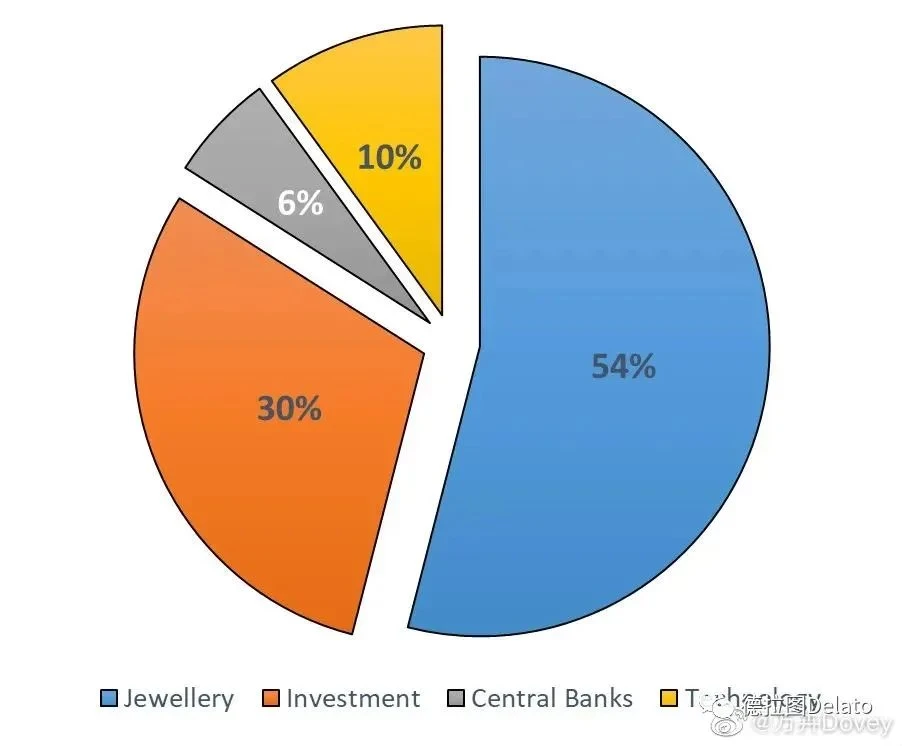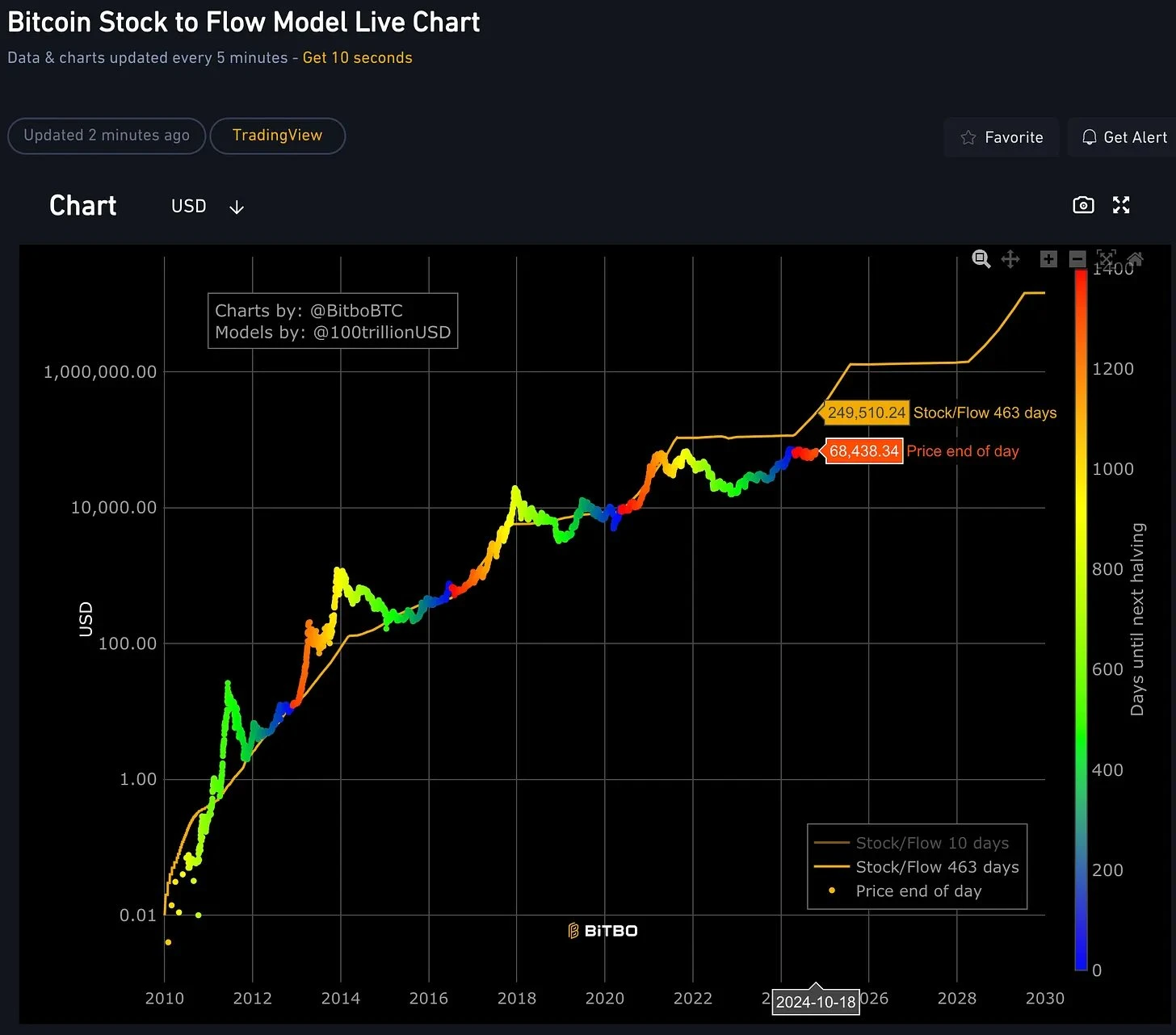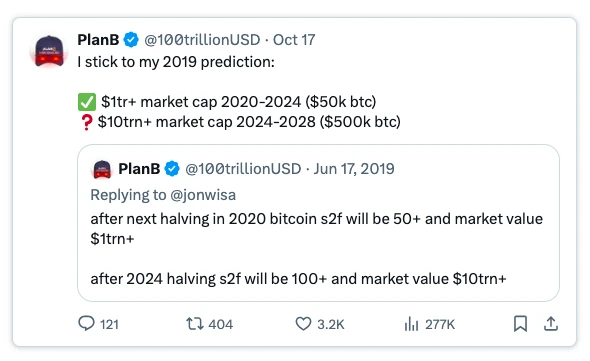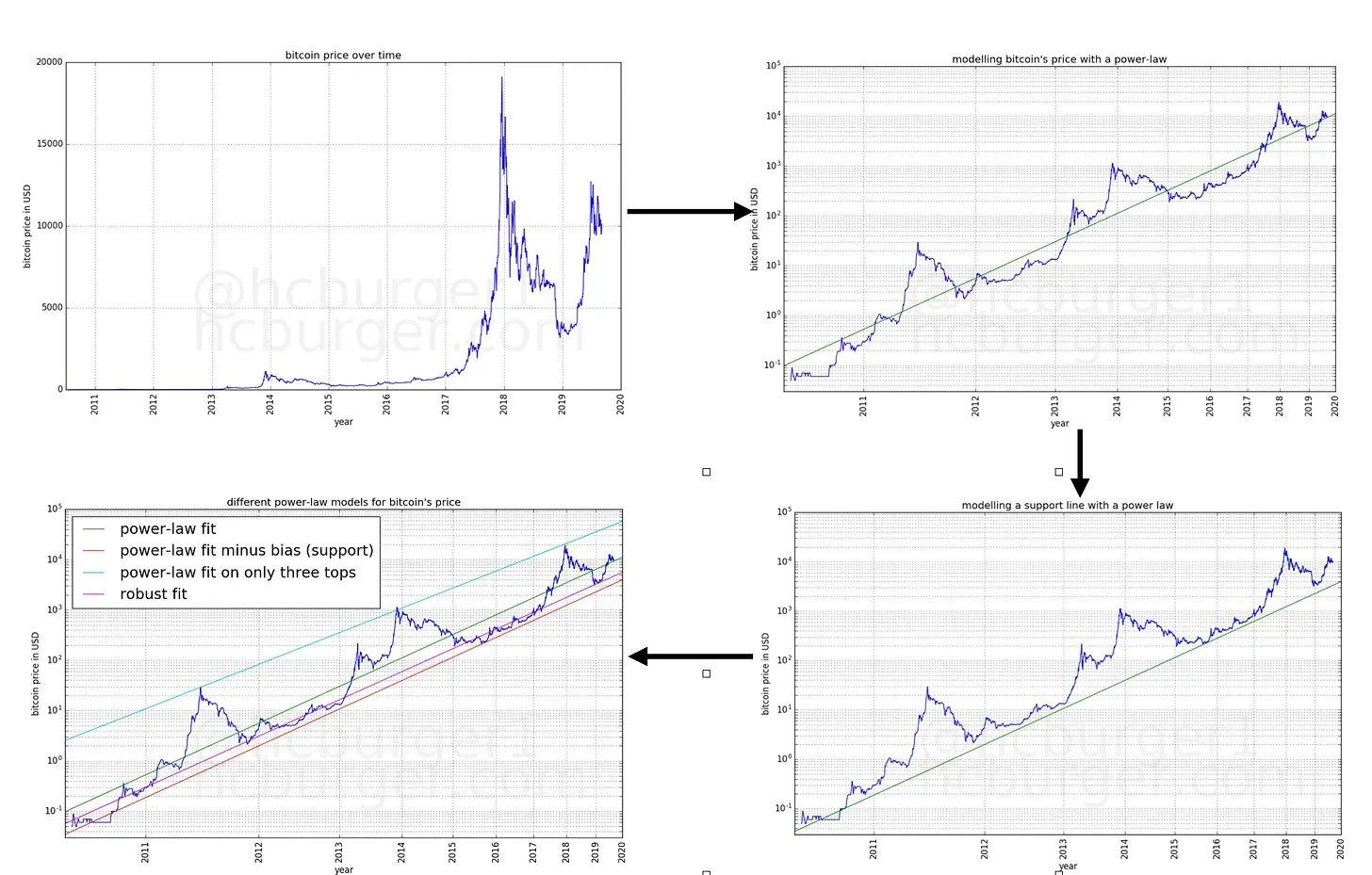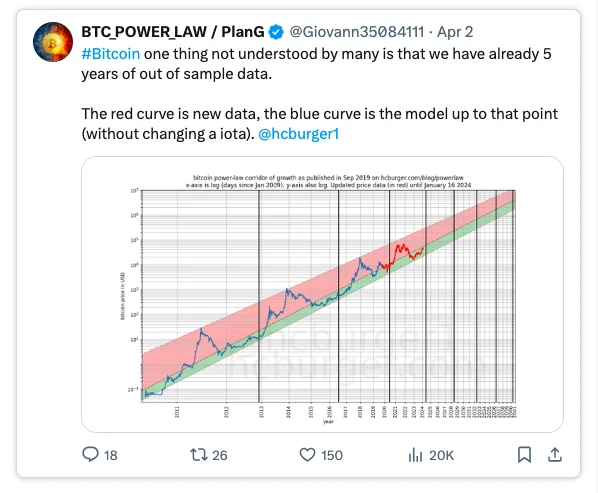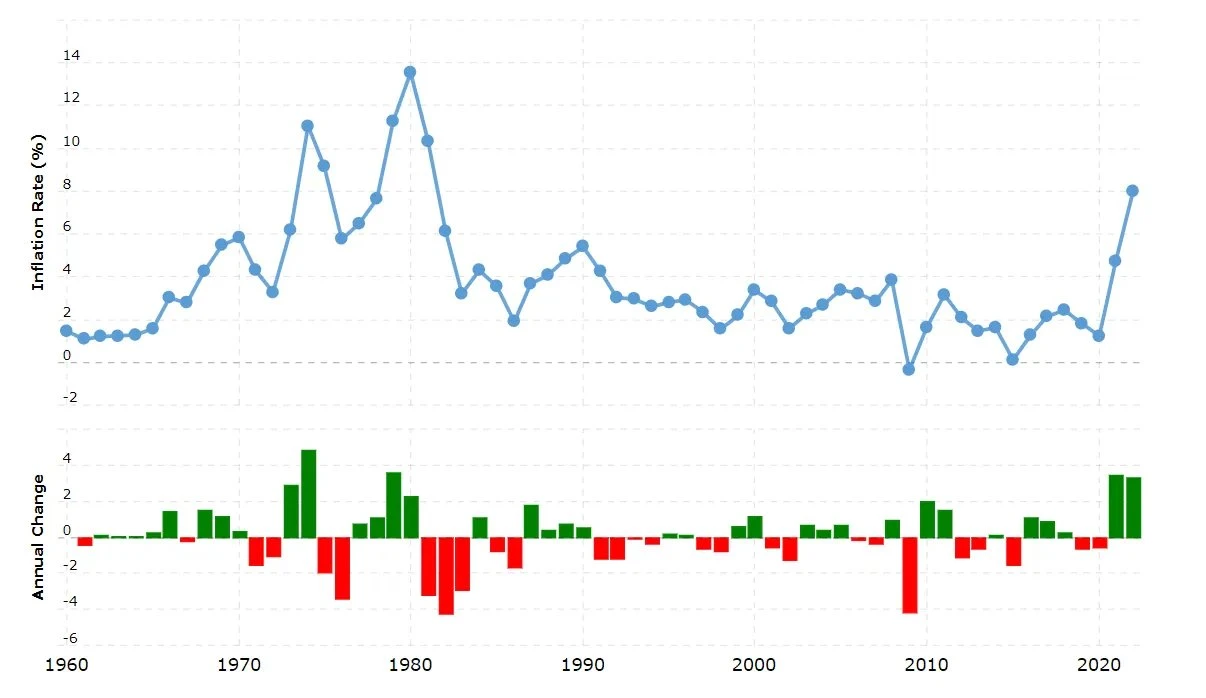7 modelos de valoración de Bitcoin: de $500,000 a $24 millones
Autor original: starzq (X: @starzqeth )
¿Estás dispuesto a mantener Bitcoin durante 4 años hasta alcanzar $500,000? Ha aumentado 90 veces en los últimos 10 años. ¿A dónde irá en los próximos 10 o incluso 20 años?
El precio de Bitcoin ha alcanzado recientemente $69,000 nuevamente. Con la liberación continua de cripto-Los factores positivos en las elecciones estadounidenses y la relajación de la economía estadounidense han hecho que cada vez más personas confíen en que el precio superará la marca de $100.000 el próximo año.
https://coinmarketcap.com/currencies/bitcoin/
Michael Saylor, director ejecutivo de MicroStrategy dijo en una entrevista reciente que Bitcoin alcanzará los 13 millones de dólares estadounidenses en 2045, lo que significa que el aumento anual promedio en los próximos 21 años alcanzará los 29%.
Como inversor/hodler a largo plazo, tengo más curiosidad por saber cuáles son los modelos de valoración de Bitcoin. ¿Cuál será la tendencia del valor a largo plazo? Por eso, recopilé y clasifiqué 7 modelos de valoración comunes, que también le dieron al comportamiento de HODL más respaldo teórico.
Si también estás interesado en el modelo de valoración de Bitcoins, ¡disfrútalo!
-
Modelo de valoración 1: Sustitutos del oro
-
Modelo de valoración 2: alternativas de activos globales
-
Modelo de valoración 3: Modelo de stock a flujo
-
Modelo de valoración 4: Ley de potencia de largo plazo
-
Modelo de valoración 5: llamadas de celebridades
-
Modelo de valoración 6: modelo de inflación del dólar estadounidense
-
Modelo de valoración 7: Basado en el costo de producción
Modelo de valoración 1: Sustitutos del oro
Este es también el método más común para valorar Bitcoin. Con una cantidad constante y resistencia a la inflación, Bitcoin se ha convertido en un nuevo medio para almacenar valor, y su contraparte en el viejo mundo es el oro.
Como objetivo de reserva de valor a largo plazo, el oro ha sido aceptado por todo el mundo y se ha convertido en un activo que trasciende las fronteras nacionales; Bitcoin, como oro digital, comenzó en la comunidad geek y ha ganado cierto consenso entre muchos jóvenes, dinero nuevo y sistemas de activos ricos (la aprobación del ETF de BTC este año fortaleció aún más el consenso), reemplazando parte del papel de reserva de valor que anteriormente desempeñaba el oro.
https://companiesmarketcap.com/assets-by-market-cap/
Actualmente (18 de octubre de 2024), el valor de mercado del oro es de $18,3 billones, y el precio unitario de Bitcoin es de $67.819, con un valor de mercado de $1,34 billones (la cantidad de monedas extraídas actualmente es de 19,76 millones, lo que está muy cerca del total de 21 millones). Se ubica como el décimo activo más grande del mundo, representando 7,3% de oro. He enumerado a continuación el precio correspondiente de Bitcoin cuando esta relación aumenta:
-
10%: $ 92,523
-
15% :$ 138.784
-
33%: $ 305, 325
-
100% :$925,226 (para alcanzar el mismo valor de mercado que el oro)
10% es el punto más alto histórico de la relación valor de mercado [Bitcoin/oro]. Si la tasa de penetración aumenta aún más, puede alcanzar 15%, lo que significa que el punto más alto de esta ronda puede rondar los 140.000 dólares estadounidenses.
¿Por qué se libera la relación 33%? Porque el valor del oro no es en su totalidad un depósito de valor. De hecho, más de la mitad se utiliza para decoración, 10% se utiliza para fines industriales y solo 1/3 se utiliza para inversión + reserva. Debido a que Bitcoin no tiene un uso decorativo o industrial, si no hay otras variables, 33% puede ser una relación máxima, en la que Bitcoin alcanza unos 300.000 dólares estadounidenses.
Si un día Bitcoin alcanza el mismo valor de mercado que el oro, el precio unitario alcanzará casi 1 millón de dólares estadounidenses.
Fuente: La edad de oro de Bitcoin
Modelo de valoración 2: alternativas de activos globales
¿Es $1 millón el fin de Bitcoin?
La respuesta es por supuesto no.
Además del oro, también utilizamos moneda y bienes inmuebles para almacenar valor. Las siguientes estimaciones provienen del famoso Nine Gods Hoarding Bitcoin (el punto temporal estimado es 2018, que se puede descargar aquí ):
-
El valor total del mercado del oro mundial es de 10T7,7 billones de dólares, el suministro monetario amplio total es de 10T90,4 billones de dólares y el de los bienes raíces es de 10T217 billones de dólares.
-
El amplio definiciónLa noción de dinero incluye efectivo, depósitos a plazo fijo y a la vista, depósitos de clientes de compañías de valores, etc. A excepción del efectivo (contabilizado en 8%) utilizado para circulación, el resto se utiliza para almacenar valor.
-
El propósito principal de los bienes raíces es probablemente vivir en ellos y usarlos, pero una proporción considerable se usa sin duda para almacenar valor. Si no fuera por Bitcoin, habría usado la mayor parte de mis fondos para comprar una casa. Como no hay una proporción que verificar, asumimos temporalmente que 20% de bienes raíces se usan para almacenar valor (esta proporción no afecta el orden de magnitud del resultado final).
Entonces, ¿qué tan grande es el mercado mundial de valor almacenado total? 7,7 + 90,4 × 92% + 217 × 20% = 134 billones de dólares estadounidenses .
Cantidad total de oro, moneda y bienes raíces en el mundo (modificado de http://money.visualcapitalist.com/ )
El número total de bitcoins es de tan solo 21 millones, y unos 3 millones se han perdido de forma permanente. Teniendo en cuenta la ventaja absoluta de los bitcoins en cuanto a almacenamiento de valor frente al oro, las divisas y los bienes inmuebles, cada bitcoin ascenderá a 7,5 millones de dólares estadounidenses.
$134 billones / $18 millones = $7,5 millones
¿Es ese el final? Por supuesto que no.
La cantidad total de riqueza mundial crece a una tasa anual de 6%. En 10 años, la cantidad total será 1,8 veces la cantidad actual, y en 20 años, la cantidad total será 3,2 veces la cantidad actual. Por lo tanto, suponiendo que la función de almacenamiento de valor de Bitcoin sea ampliamente reconocida en 20 años (2038), su precio debería ser de 24 millones de dólares estadounidenses, o 160 millones de RMB.
Por supuesto, este es el caso cuando Bitcoin ocupa 100% del mercado total de almacenamiento global. Si alcanza 10% de la cuota de mercado, el precio de Bitcoin alcanzará los 2,4 millones de dólares estadounidenses, o 16 millones de RMB, en 2038.
Para la versión más radical [160 millones de RMB], Jiushen también elaboró modelos de precios lineales y exponenciales:
-
Crecimiento lineal” (en realidad no lineal en matemáticas): el múltiplo de crecimiento es el mismo en cada ciclo;
-
“Decreciente exponencial”: el múltiplo de crecimiento es alto al principio y bajo más adelante.
Predicciones del precio de Bitcoin para dos modelos de crecimiento, en RMB
La predicción anterior se realizó en 2018. A fines de 2021, el precio de Bitcoin alcanzó $64,863, aproximadamente 450,000 RMB, lo que está bastante cerca de la predicción de Jiushen. ¿Este ciclo alcanzará los 3,4 millones de RMB / 500,000 USD en la tabla?
Por cierto, otra gran aportación de Jiushen es la invención del famoso Índice de acaparamiento de Jiushen , cual guías inversión fija y pesca de fondo (yo mismo uso este indicador):
AHR 999 = (precio de Bitcoin/costo de inversión fijo de 200 días) * (precio de Bitcoin/valoración del crecimiento del índice)
• Valoración de crecimiento exponencial = 10 ^[ 5,84 * log(moneda) – 17,01 ]
• Antigüedad de la moneda = número de días desde la fecha actual hasta el bloque génesis de Bitcoin (3 de enero de 2009)
Backtesting basado en indicadores
-
Cuando los datos del indicador ahr 999 están por debajo de 0,45, puede ser adecuado para la búsqueda de fondo;
-
Puede ser conveniente invertir en BTC entre 0,45 y 1,2
-
Si está por encima de este rango, significa que puede que no sea un buen momento para realizar una inversión fija.
Modelo de valoración 3: Modelo de stock a flujo
En 2019, el usuario de Twitter Plan B Añadió la consideración de escasez al sustituto del oro y propuso El modelo de stock a flujo .
Describimos este modelo en tres partes:
-
Los bienes escasos pueden utilizarse para almacenar valor y desempeñar el papel de moneda.
-
La escasez se puede cuantificar mediante la relación existencias/flujo;
-
Modelado final
1. Los bienes escasos pueden utilizarse para almacenar valor y desempeñar el papel de moneda.
Esto debería explicarse por sí solo, y simplemente citaré las palabras del pionero del cypherpunk Nick Szabo en el artículo:
¿Qué tienen en común las antigüedades, el tiempo y el oro? Todos son caros, ya sea por su coste original o porque su historia es impredecible y difícil de falsificar. Los metales preciosos y los objetos de colección tienen una escasez infalsificable debido a sus elevados costes de fabricación.
Esto ha proporcionado valor a la moneda, cuya valor es en gran medida independiente de cualquier tercero de confianza. Por lo tanto, sería fantástico si existiera un protocolo que pudiera crear bits costosos e infalsificables en línea con una dependencia mínima de terceros confiables, y luego almacenarlos, transferirlos y verificarlos de manera segura con una confianza mínima similar a la de Bitcoin Gold.
Por cierto, se sospecha que Nick Szabo es Satoshi Nakamoto debido a su experiencia profesional y estilo de escritura similares, pero él lo ha negado muchas veces.
2. La escasez se puede cuantificar mediante la relación entre existencias y flujo.
El estudioso de Bitcoin Saifedean Ammous introdujo además el concepto de relación stock-flujo para cuantificar la escasez.
Como ocurre con cualquier bien de consumo, duplicar la producción eclipsaría las existencias existentes, haciendo caer los precios y perjudicando a los tenedores.
En el caso del oro, una duplicación de la producción anual como resultado de un aumento de precios sería insignificante, aumentando las reservas en sólo 3%.
Es precisamente debido a la continua baja tasa de suministro del oro que este ha mantenido su papel monetario a lo largo de la historia de la humanidad.
La alta relación entre existencias y flujos del oro lo convierte en el producto básico con la oferta menos elástica.
Las reservas existentes de Bitcoin en 2017 son aproximadamente 25 veces la cantidad de nuevos Bitcoin creados en 2017. Esto todavía es menos de la mitad de la proporción áurea, pero alrededor de 2022, la relación [existencias-flujo] de Bitcoin superará a la del oro.
Relación stock-flujo (SF) = stock/flujo
-
El stock es la cantidad total de bienes corrientes
-
El flujo se refiere al suministro anual del producto actual.
El autor da la relación inventario-flujo de varios productos en ese momento (23.3.2019) en el artículo:
El oro tiene el SF más alto, 62, y se necesitan 62 años de producción para obtener las reservas de oro actuales. La plata ocupa el segundo lugar, con un SF de 22. Este alto SF los convierte a ambos en productos monetarios.
El paladio, el platino y todos los demás productos básicos tienen SF superiores a 1. Las existencias disponibles suelen ser iguales o inferiores a la producción anual, lo que hace de la producción un factor muy importante.
Es difícil que las materias primas tengan un SF más alto porque, una vez que la gente las acapara, el precio sube, la producción aumenta y el precio vuelve a bajar. Es difícil escapar de esta trampa.
El suministro actual de Bitcoin es de 17,5 millones, con un suministro de 700.000 al año = SF 25. Esto coloca a Bitcoin en la categoría de productos monetarios como la plata y el oro. El valor de mercado de Bitcoin al precio actual ($4.000) es de $70 mil millones.
También se puede ver en la tabla anterior que el SF es proporcional al valor de dichos productos, y la reducción a la mitad de Bitcoin hará que el SF de Bitcoin continúe aumentando, aumentando así su valor.
En efecto, según las estadísticas de Biteye ,
La relación stock-flujo de Bitcoins es: 19750000 / 164359 ≈ 120,1 (agosto de 2024)
La relación stock-flujo del oro es: 209.000 / 3.500 ≈ 59,7 (2023)
La relación stock-flujo del oro no es muy diferente a la de 2019, pero la del Bitcoin ha aumentado más de 3 veces y actualmente es el doble que la del oro. En otras palabras, la escasez del Bitcoin es aproximadamente el doble que la del oro. ¿Cómo se reflejará esto en la predicción del valor del Bitcoin?
3. Modelado final
El modelo de PlanB asume que la escasez, representada por SF, impulsa directamente el valor de Bitcoin.
Saltándose el proceso de derivación intermedio, la fórmula final es: Mercado valor = exp(14,6) * SF ^ 3,3 (una distribución de ley de potencia)
https://charts.bitbo.io/stock-to-flow/
Se puede observar que este modelo Stock-to-Flow ha sido bastante preciso en las predicciones desde que se propuso el 23 de marzo de 2019, hasta mayo de 2021, y luego hubo una situación en la que el precio previsto era mucho más alto que el precio real.
According to this model, the current predicted price is 250,000 US dollars ?
Sin embargo, el autor predijo que el precio alcanzaría $55,000 dentro de uno o dos años después del halving en mayo de 2020, y el valor de mercado de Bitcoin superaría el billón de dólares estadounidenses (9 de marzo de 2021), lo que también hizo famoso a Plan B en Twitter.
Y también predijo de dónde vendría todo el dinero necesario para una capitalización de mercado de Bitcoin de $1 billón:
Mi respuesta: Plata, oro, países con tasas de interés negativas (Europa, Japón, Estados Unidos pronto), gobiernos depredadores (Venezuela, China, Irán, Turquía, etc.), multimillonarios y millonarios que se protegen contra la flexibilización cuantitativa (QE) e inversores institucionales que descubren los activos con mejor rendimiento de los últimos 10 años.
El propio Plan B sigue fiel a su predicción
Después del halving en 2024, Bitcoin alcanzará $500,000 para 2028, y su valor de mercado alcanzará más de $10 billones
¿Sucederá? Tendremos que esperar y ver.
Modelo de valoración 4: Ley de potencia de largo plazo Método de predicción de la ley de potencia de largo plazo
Después de que PlanB propusiera el modelo Stock-to-Flow en 2019, muchas personas también notaron la distribución de la ley de potencia temporal de los precios de Bitcoin al mismo tiempo, y Harold Christopher Burger fue uno de ellos. Estudió un doctorado en el Instituto Max Planck y ahora es un experto en inteligencia artificial.
Publicó un artículo titulado “ bitcóin Corredor de crecimiento de ley de potencia natural a largo plazo " el 3 de septiembre de 2019 , que hizo predicciones a largo plazo sobre los máximos y mínimos del mercado de los precios de Bitcoin:
-
El precio de Bitcoin alcanzará $100,000 por Bitcoin entre 2021 y 2028, y después de 2028, el precio nunca será inferior a $100,000.
-
El precio de Bitcoin alcanzará $1 millón por Bitcoin entre 2028 y 2037, y después de 2037, el precio nunca caerá por debajo de $1 millón.
Este modelo es bastante fácil de entender:
-
Para la distribución del precio-tiempo de Bitcoins, después de tomar el logaritmo tanto del eje y (precio) como del eje x (tiempo), se puede ajustar mediante regresión lineal.
-
Desplazando ligeramente hacia abajo la línea ajustada anterior (pero sin cambiar la pendiente), obtenemos la línea de soporte para el precio de Bitcoin;
-
Realizando una regresión lineal solo en los tres puntos más altos alcanzados en 2011, 2013 y 2017, obtenemos una línea de ley de potencia para el pico del mercado;
-
El precio de Bitcoin fluctúa entre dos líneas de ley de potencia: una línea de soporte inferior y una línea superior definida por tres máximos del mercado.
https://hcburger.com/blog/powerlaw/
El poder de este modelo radica en que los datos de los cinco años posteriores a su propuesta (septiembre de 2019-septiembre de 2024) todavía están dentro de su rango de predicción, por lo que parece que no está lejos de $100.000.
Modelo de valoración 5: llamadas de celebridades
Debo admitir que esta parte es bastante entretenida y es más bien un registro de una época. Aquí hay tres representativas:
La directora ejecutiva de ARK Invest, Cathie Wood, predijo en enero de 2024 que Bitcoin crecerá a $1,5 millones Para el año 2030 .
El ex director ejecutivo de Twitter, Jack Dorsey Previsto para mayo de 2024 que superaría la marca de $1 millón para finales de 2030.
Michael Saylor de MicroStrategy dijo en una entrevista reciente que Bitcoin alcanzará los 13 millones de dólares estadounidenses en 2045, lo que significa que el aumento anual promedio en los próximos 21 años alcanzará los 29%.
Sin embargo, aunque es entretenimiento, el mercado de criptomonedas aún tiene una fuerte reflexividad, y los pedidos de celebridades de hecho afectarán los precios locales en algunos momentos especiales.
Modelo de valoración 6: modelo de inflación del dólar estadounidense
fuente: https://www.tastycrypto.com/blog/bitcoin-price-predictions/
Si hacemos previsiones de precios en unidades de 10 años, debemos tener en cuenta el impacto de la inflación del dólar estadounidense, que puede provocar aumentos significativos en los precios de los activos.
A diferencia de Bitcoin, el dólar es un activo inflacionario y la Reserva Federal tiene un objetivo de inflación de 2%. Sin embargo, no somos robots y es un desafío controlar completamente la economía. Los bancos centrales a menudo imprimen más dinero al reducir las tasas de interés para estimular el crecimiento económico, especialmente en tiempos difíciles como la pandemia. Es por eso que tenemos un aumento repentino de la inflación, con una tasa anual de 8%, la más alta en aproximadamente 40 años.
https://www.macrotrends.net/global-metrics/countries/USA/united-states/inflation-rate-cpi
Debido a la creciente inflación, el poder adquisitivo del dólar está disminuyendo. Por ejemplo, $100 en 1984 vale más que $300 hoy.
Considerando solo este factor, el precio actual de Bitcoin de $69,400 (2024.4) podría llegar a alrededor de $200,000 para 2050, sin considerar otros factores fundamentales.
(Creo que muchas predicciones de celebridades también tienen en cuenta la inflación)
De hecho, si el dólar pierde su condición de moneda de reserva mundial, lo que podría suceder debido a la actual cambios geopolíticos tectónicos , esto podría llevar a hiperinflación (aunque es extremadamente improbable), lo que eleva el precio de Bitcoin a cifras astronómicas.
Modelo de valoración 7: Basado en el costo de producción
Esto también es fácil de entender. Para los mineros, Bitcoin es un negocio que genera flujo de efectivo y ganancias. El precio de cierre de las máquinas mineras a menudo marca el precio mínimo durante un período de tiempo y se puede utilizar para orientar la pesca de fondo (pero es difícil utilizarlo para orientar los aumentos de precios).
Bueno, estos son los 7 modelos de valoración de Bitcoin. Para los amigos que estén interesados en los detalles, he adjuntado enlaces en cada sección, y pueden profundizar en ellos por su cuenta. Si conoce otros métodos de valoración importantes que no se han mencionado anteriormente, también puede dejar un mensaje para complementarlos.
Esperamos que estos modelos de valoración puedan ayudarle a comprender, invertir y conservar mejor Bitcoin.
Este artículo proviene de Internet: 7 modelos de valoración de Bitcoin: de $500,000 a $24 millones




